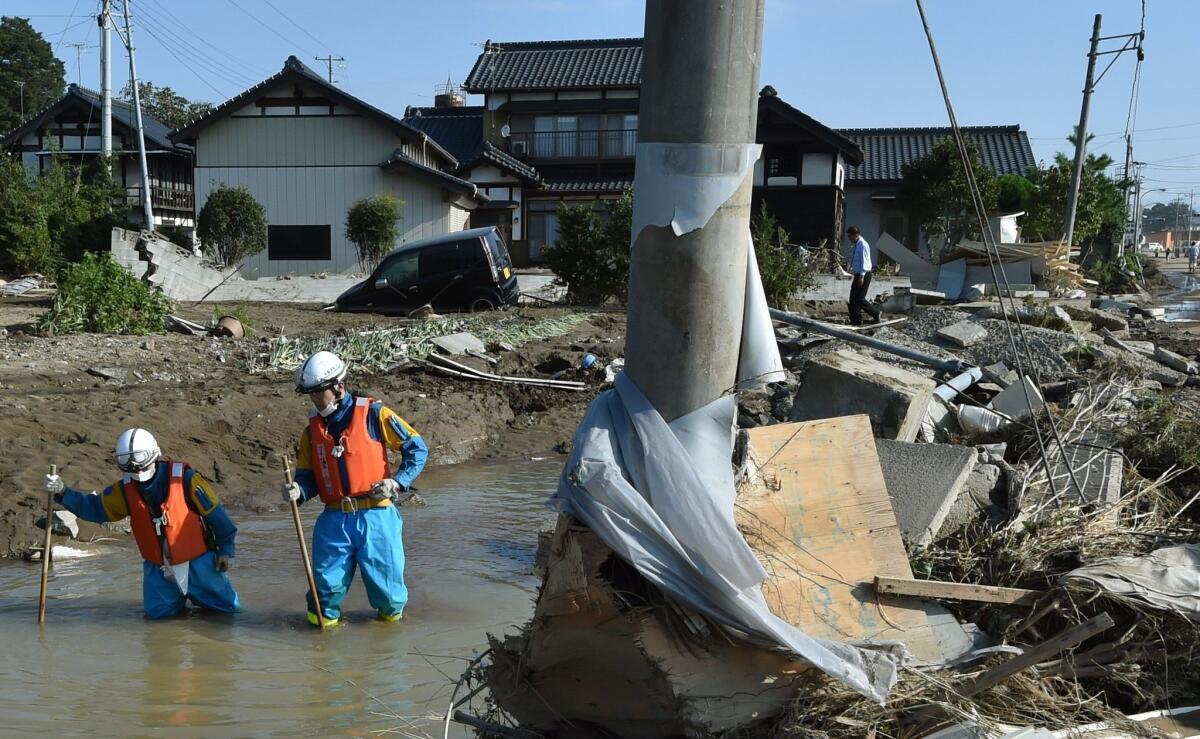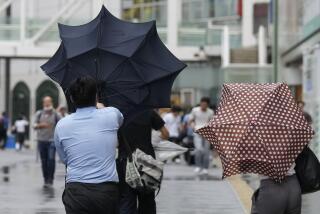Fifteen remain missing in Japan flooding

Police wade through water as they provide assistance Saturday following Thursday’s flooding in Joso City, Japan.
- Share via
Reporting from Joso City, Japan — Saori Kuwabara, 39, was busy wiping mud off her family’s possessions Saturday. The office in their Joso City home north of Tokyo was stained by a brown pool of water.
“I want to wash the floor off but I can’t,” said Kuwabara, an office worker. “No water.”
In some ways, the lack of additional water was refreshing. Two days earlier, heavy rains from Typhoon Etau had resulted in widespread flooding in several neighborhoods of the city of in Ibaraki Prefecture.
When a short stretch of the levee for the Kinugawa River broke, the raging waters submerged nearly 4,600 properties. Local government officials said Saturday that 15 people remained missing; the record-setting rains were responsible for four deaths elsewhere in Japan, authorities said.
More than 5,000 people have been evacuated from their residences in Ibaraki Prefecture, with nine of them having suffered injuries. Officials said some 3,600 Joso residents have been housed in evacuation shelters.
Kuwabara and her family of four were housed at a shelter in Tsukuba City, where there was water and electricity. Groceries and other shops in their own neighborhood remained closed Saturday and food could not be stored at home because of a lack of electricity.
Kuwabara said she planned to go back to work at an office on the other side of the Kinugawa River on Monday. She said, though, that the office may remain closed if many of her colleagues find it a challenge to resume work.
“We will put in all of our energy to quickly restore the embankment that broke to prevent another disaster from happening,” Prime Minister Shinzo Abe said during an inspection visit to Joso.
Officers from Japan’s self-defense forces, police and fire departments, some wearing surgical masks, sought to help clean up the disaster area, where 11,700 houses were without water and many also had no electricity.
Eiji Saito, deputy manager at Joso City, was heading up the shelter at the city community center. When the water has receded in his section of town, hundreds of evacuees left, he said. His shelter remains open to supply residents with food, water, blankets and necessities including toilet paper and diapers, Saito said.
‘Hanako’ Ichikawa, 61, a part-time nursery school teacher, has been staying at the Joso City Hall shelter since Thursday. Ichikawa and her husband’s home remained three feet deep in mud and water this weekend.
“It’s been hard,” Ichikawa said. She said she hasn’t been able to shower in two days and she did not have a change of clothes..
“I evacuated from the house thinking I’ll be right back,” Ichikawa said.
Ichikawa said she was glad her dog also survived the flooding and was housed with her at the shelter. She said she hoped she could return to her normal life soon.
The flooding drew widespread attention when national TV broadcasts showed a man isolated in a raging stream, grabbing onto a utlity pole. Several other residents waited on second-floor balconies or rooftops to be airlifted to safety.
Nagano is a special correspondent.
ALSO
104 killed, 100 injured in explosion near central India bus stop
Severe flooding in Japan washes away homes, strands dozens on rooftops
A heavy price paid for botched terrorist raid by Philippines and U.S.
More to Read
Sign up for Essential California
The most important California stories and recommendations in your inbox every morning.
You may occasionally receive promotional content from the Los Angeles Times.










